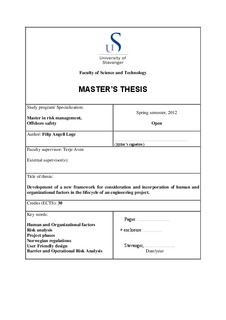| dc.description.abstract | There has been a large development on safety related issues and methods during the last 50 years since oil production started on the NCS. There has been a shift from prescriptive regulations towards today´s functional requirements. Several major accidents have contributed to this development. Risk analysis and emergency preparedness disciplines have emerged and is still evolving to meet the lower tolerability from authorities and the public for accidents and losses.
In order to prevent accidents there has been put a large effort in design, implementation and maintenance of physical barriers. Their function is to intervene in the accident chain such that an initiating event does not escalate to major accidents. The implementation of such barriers has been a success story on the NCS, preventing many major accidents. There has not been an ignited gas leak on the NCS since 1993.
However, on a yearly basis, many (100-200) gas leaks still occur on installations on the NCS. Good ignition control, luck and coincidences are the main causes of no ignition. With so many releases it is only a question of time before circumstances allowing ignition occurs.
It seems to be a common understanding in risk and safety related communities in that the main potential for risk reduction lies in preventing HC leakages. Much research has been conducted to reveal their imminent and underlying causes. One of the main conclusions has been that HC leakages are often caused during manual override, implying some sort of human error an underlying cause.
It has for a long time been recognized that the risk analyses and QRA´s does not in a sufficient manner consider human errors as a cause and part of the accident chain. Several scientific reports have documented this weakness. There has also during the last 15 years been developed several tools and methods for modeling of human errors, but they has not been applied by the industry.
The objective of this thesis has been to develop a framework for consideration and incorporation of human and organizational factors in the lifecycle of an engineering project. That is, a recipe for what methods to implement at different project stages in order to make sure that the risks of human errors are reduced as much as possible. Both the concept, design and operation phase are considered. In the design phases a method taking the form of a brainstorming session is applied, which is developed by Trevor Kletz and called “User Friendly Design”. The purpose it to stimulate creativity and solutions through improved design that are user friendly for the personnel responsible during operation and maintenance. A much debated issue has been that safety experts are involved at a too late stage, such that they just have to add safety systems and equipment to the design in order to make them safe. That will make the design extrinsically safer, but it would be better to make the intrinsically safer by improving the design and design process. Risk analysis and QRA´s will still have to be conducted in order to verify RAC´s and suggest improvements. They should consider human errors and their risk influencing factors. A recently developed method called BORA is judged to be best suited for this purpose and practicable to use. By applying this method in the QRA it should give better decision support because measures not only of technical nature, related to increased reliability etc (barrier perspective) are considered, but also in relation to improved safety culture and risk awareness (operational conditions).
Another important part of this thesis has been to identify the regulatory requirements specified in PSA guidelines and standards (NORSOK Z-013) related to handling of operational issues in risk analyses. There are specific requirements that HOF shall be considered, and the extent depends on the criticality for the risk picture. | no_NO |
